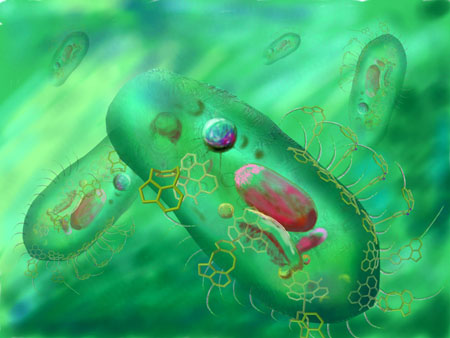| Posted: Jul 04, 2014 |
Nanotechnology researchers develop bionic emulation of a billions of years old biological transportation system
|
|
(Nanowerk News) For billions of years, bacteria move along using cilia. These propeling organelles are ubiquitous and they are even found in almost any human cell. Following the natural paragon scientists at the Kiel University constructed molecules that imitate these tiny, hair-like structures. Autonomously moving artificial organelles and a more efficient production of chemical compounds might now be within reach. The researchers recently published their results in the scientific journal European Journal of Organic Chemistry ("Diazocines on Molecular Platforms").
|
 |
| Artistic depiction of paramecia with artificial cilia: Chiral, unidirectional molecular switches mounted on surfaces are the prerequisite for inducing cilia driven directed motion. Scientists from Kiel transformed simple azobenzenes to chiral switches equipped with a molecular platform to mount them on gold surfaces. This bionic emulation of a billions of years old biological transportation system might be used in nano fabrication in the future. (Illustration: Herges)
|
|
Cilia, or ciliated epithelia, cover our respiratory tract like a lawn. In our pharynx and nasal mucosa they are responsible for continuously transporting mucus and particles embedded therein towards our throat. (except for heavy smokers, whose cilia where destroyed by nicotine and tar.) Tobias Tellkamp and Professor Rainer Herges have now come one step closer to their aim of artificially reproducing this biological transport system with switchable molecules.
|
|
Molecules that wiggle when exposed to light are known for a long time. But directed movement had not been possible up until now because back and forth movement cancel each other. To achieve a net displacement, the cilia should beat only to one side. Applying a trick within the molecular construction, the chemists of Kiel University’s Collaborative Research Centre 677 "Function by Switching" solved this problem: Moreover, to get those molecular cilia up and running, the scientists fixed them on a surface. “We attached a kind of molecular suction cup onto the switches”, project leader Herges explains.
|
|
Studies have shown that this suction cup adheres very well to gold surfaces. The team of scientists observed that the molecules self-assemble autonomously on the surface, densely packed, side by side like oranges on a shelf. “The suction cups adhere to the surface but they are still mobile and attract one another”, explains doctoral candidate Tellkamp. In this way, an artificial epithelium is formed.
|
|
The next logical step is to find out if the artificial epithelium works much in the same way as our nasal mucosa. In collaboration with Prof. Olaf Magnussen in the Physics Department of Kiel University atomic force microscopy (AFM) will be used to visualize the light driven, directed transport of nanoscopic particles.
The recent findings are particularly interesting, not only with respect to fundamental research. With artificially ciliated epithelia, a molecular nano-fabrication seems possible – machines of molecular size would build other machines by positioning chemical products specifically and precisely. Entire production plants could thus fit onto a tiny chip. Other conceivable fields of application include artificial organelles equipped with molecular cilia that are controlled by an external stimulus; or in the more distant future, they could operate autonomously within the bloodstream and carry drugs to the site of a disease.
|

